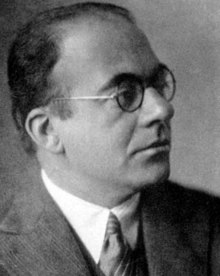
Back Erwin Panofsky AN إروين بانوفسكي Arabic اروين بانوفسكى ARZ Erwin Panofsky AST Ервин Панофски Bulgarian Erwin Panofsky Catalan Erwin Panofsky Czech Erwin Panofsky Danish Erwin Panofsky German Έρβιν Πανόφσκι Greek
Erwin Panofsky | |
|---|---|
 Panofsky in the 1920s | |
| Born | March 30, 1892 Hannover, Germany |
| Died | March 14, 1968 (aged 75) |
Erwin Panofsky (March 30, 1892, in Hannover – March 14, 1968, in Princeton, New Jersey)[1] was a German-Jewish art historian, whose academic career was pursued mostly in the U.S. after the rise of the Nazi regime.
His work represents a high point in the modern academic study of iconography, including his hugely influential[2] Renaissance and Renascences in Western Art and his masterpiece Early Netherlandish Painting.[2] Many of his books are still in print, including Studies in Iconology: Humanist Themes in the Art of the Renaissance (1939), Meaning in the Visual Arts (1955), and his 1943 study The Life and Art of Albrecht Dürer.
Panofsky's ideas were highly influential in intellectual history in general,[3] particularly in his use of historical ideas to interpret artworks and vice versa.
- ^ "Erwin Panofsky – Dictionary of Art Historians". arthistorians.info. Archived from the original on March 3, 2020. Retrieved March 25, 2016.
- ^ a b Shone, Richard and Stonard, John-Paul, eds. The Books that Shaped Art History, chapter 7. London: Thames & Hudson, 2013.
- ^ Chartier, Roger. Cultural History, pp. 23–24 (from "Intellectual History and the History of Mentalités"). Ithaca: Cornell University Press, 1988
© MMXXIII Rich X Search. We shall prevail. All rights reserved. Rich X Search